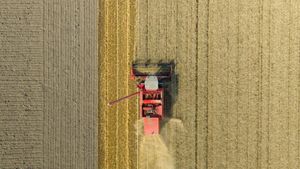The agricultural community is grappling with the impacts of the recent bird flu outbreak, especially as the virus has begun affecting both poultry and dairy farms across the United States. The highly pathogenic avian influenza (HPAI) strain known as H5N1 has been wreaking havoc on farms, leading to the culling of millions of birds and prompting federal health officials to issue new guidelines for testing workers on farms where outbreaks have occurred.
Recent reports indicate a significant increase in the number of infected animals, with over 90 million poultry, including chickens and turkeys, either euthanized or infected due to the virus. This turmoil has resulted not only in higher prices for poultry products but also raised concerns about the safety of various food items. For example, egg prices, which have nearly doubled in California due to the reduced supply, are now higher than they have been for years. Farmers are facing the grim reality of decreased production, with turkey populations at their lowest levels in almost four decades.
On November 28, 2024, the U.S. Centers for Disease Control and Prevention (CDC) revealed troubling findings from recent studies highlighting the need for aggressive testing among farmworkers who come in direct contact with infected animals. The latest guidelines specify the necessity to test workers even when they are asymptomatic to curb any unrecognized spread of the virus. Nirav Shah, principal director of the CDC, emphasized the importance of protecting workers, limiting transmission to humans, and mitigating the risk of the virus muting dangerously.
A troubling aspect of the outbreak is the lack of comprehensive testing. While states such as Michigan and Colorado have commenced testing protocols resulting from the recent studies — which found antibodies for the H5N1 virus among 7% of tested dairy workers — other states remain inconsistent with testing practices. For example, Idaho has conducted only seven human tests, indicating substantial gaps within monitoring and response efforts.
"Regular testing helps health officials understand how the virus is transmitted and protect workers," stated Amy Liebman, chief program officer of Migrant Clinicians Network. Without consistent testing, health agencies cannot fully gauge the extent of human infections among farmworkers, leading to untracked cases of the bird flu. Farmworkers often face challenges with accessing testing due to fears of losing wages if they take time off for health concerns. This situation becomes particularly dire for undocumented workers who might avoid seeking medical help entirely.
While human cases linked to the virus remain low compared to avian infections, there are increasing concerns from health experts about the potential for the virus to mutate and acquire the ability to transmit between humans. Recent data revealed 55 confirmed human cases across the U.S., with 28 occurrences recorded solely within California. Mild symptoms have mainly included conjunctivitis and flu-like discomfort, yet the prevailing atmosphere of uncertainty raises alarms about the future.
Health advocates are pushing for heightened surveillance and testing, particularly because the economic repercussions of the bird flu also threaten the livelihoods of agricultural workers. Farmers, who have witnessed firsthand the impacts of the virus on their operations, echo concerns about the long-term sustainability of their work with the added threat of potential human illness.
Alongside this, as health officials warn about doing more to monitor the impacts of the bird flu, they also urge consumers to exercise caution when it involves raw milk products. A recall of cream-top raw milk from Raw Farm, LLC demonstrates the real threats posed by the virus, where testing confirmed the presence of H5N1 within products sold to consumers. This incident serves as another reminder for public vigilance and the need for continued testing and oversight within agricultural communities.
The CDC's recent adjustments to its testing guidelines signify recognition of the virus's slippery reach from birds to farm mammals and, potentially, humans. With positive cases identified at poultry farms across the Pacific Northwest, testing measures could have serious ramifications not only for the current handling of outbreaks but also for the broader public health frameworks surrounding food production.
The struggling supply chain and ballooning prices of poultry products could lead consumers to redirect their focus and put pressure on legislative bodies to act. Ensuring worker safety through adequate testing and preventive care can help mitigate the overall impact of this disease on food supply lines. Continued collaboration between health agencies, farmers, and local communities will be key to managing the current crisis.
Experts warn against underestimations of H5N1's risks. Direct contact with infected animals can lead to human infections, and every new case could present the chance for mutations. Angela Rasmussen, a virologist, pointed out how cultivating transmissibility between species without strict monitoring could spell disaster. "Our luck will eventually run out if we keep letting this virus spread and jump from species to species,” she passionately stated.
Making progress against this outbreak won’t be easy. The tension between economic necessity and health safety for low-wage farmworkers complicates potential solutions. Solutions could require legislative support for workplace accommodations, such as paid sick leave, to encourage testing and maintain public health. These strategies will not just protect farmworkers but would also contribute to the broader safety of agricultural products for consumers, which remains the ultimate priority.
Across the U.S., state officials continue to monitor the spread of avian influenza cautiously, reinforcing the importance of surveillance to prevent future outbreaks. The interaction between human health and poultry farming practices becomes increasingly evident, as both spheres deeply influence each other. This interconnectedness raises questions not only about the immediate containment efforts but also about long-term strategies to address the underlying health challenges relevant to food security.



